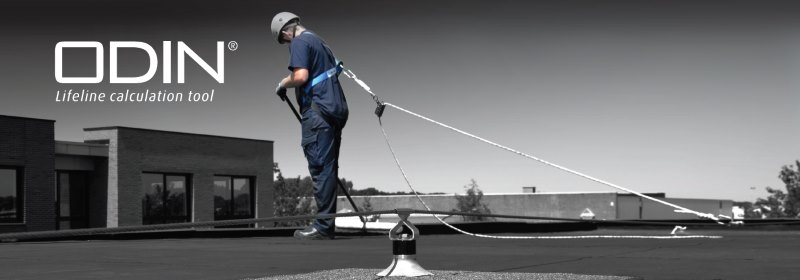
Horizontal lifeline systems are an often used solution for safely working at height. The system consists of multiple anchor points, connected via a flexible line to which users attach their lanyard. A horizontal lifeline can be installed on most roof surfaces, walls or overhead structures. Most horizontal lifelines must be designed specifically for a project.
Properly calculating a lifeline is complex, but mandatory. After all users have to be able to rely on the system to prevent them from falling (work restraint) or for arresting their fall (fall arrest) should one occur. The calculation of a horizontal lifeline system is complicated because of the amount of variables involved, not to mention that every project is unique.
Because of this complexity and because a horizontal lifeline is literally a user’s life line various health and safety bodies in different countries require that the design of a custom lifeline system is verified by testing and certified by an engineer or suitably qualified person.
OSHA requires that a qualified person supervises the design of a horizontal lifeline system for fall arrest (29 CFR 1926.502(d)(8)).
A lifeline installation should be verified appropriately by calculation or testing (EN 795:2012) and (CEN/TS 16415:2013).
A horizontal lifeline system shall be designed and all drawings should be sealed by a professional engineer (CSA Z259.16-04).
Next to this building owners or employers, who are responsible for the safety of the user, want to be certain that a system is safe and that they have done their duty in supplying adequate fall protection. As a reminder: As a safety advisor you are obligated to prove the lifeline system you are offering is safe and complies with the applicable standard.
Horizontal Lifeline Design and calculation
There is a whole list of variables that influence the performance of a horizontal lifeline, for example the length of the system and the number of spans. After all, a lifeline is flexible, it will deflect in the direction of a fallen person. The greater the sag in the line, the farther the free fall. This will have to be calculated carefully otherwise the available fall clearance may be exceeded, and a worker could hit a lower level.
Special attention also needs to be given to the forces released in case a fall occurs. Not only will the forces exerted on the user have to be limited, the lifeline and its anchor points will also have to be able to withstand them without breaking or tearing up the surface material.
As you can read, calculating a system configuration can be time consuming because of all the details you have to take into account. This is why XSPlatforms developed a special calculation tool for our lifeline systems.

Advantages of a lifeline calculation tool
A lifeline calculation tool, such as ODIN, helps users calculate a horizontal lifeline setup, without the possibility of miscalculations because you aren’t manually calculating the system. ODIN asks you to fill in a set of variables and then creates the calculation for you, based on the most precise data in the market. Saving loads of time and eliminating errors.
XSPlatforms’ ODIN ensures you and your clients that the lifeline system complies with the applicable standard. Making a calculation with ODIN offers the end-user complete safety documentation, including test results and instructions. This documentation can be used to prove the system is conform the applicable standards if a Health and Safety governing body comes to check the workplace (legal responsibilities). The documentation, however can also be used in insurance or liability cases.
Advantages of ODIN
-
Calculates both fall restraint and fall arrest systems.
-
Roof, wall and overhead calculations.
-
Reduces the risk of miscalculations because no manual calculations have to be executed.
-
ODIN calculates the system quickly, reducing the time necessary to make a calculation.
-
Based on the most precise calculations in the market.
-
ODIN can verify if the custom lifeline complies with:
- EN795:2012 & CEN/TS16415 (Europe),
- ANSI 2359.6:2009 (United States),
- CSA 2259.16-04:2009 (Canada).
-
Complete set of safety documentation with test results and instructions.
-
Assurance that the system meets the project requirements.
-
Online tool which can be accessed from any computer with access to internet, no installation necessary.
How does it work?
ODIN calculates the dynamic behavior of a complete fall protection system. The system allows you to test designs and loads to ensure the right system is chosen for the application. You fill in the project information, such as the applicable standard (EN, ANSI or CSA) and the foundation material. Then you move on to the system setup. This is where you specify, for example, the amount of users and the layout of the system.
When all the required information is entered, ODIN will make several in depth calculations of the proposed system for you. In the results overview you will see the verification of the system. If it passes the essential tests, such as sufficient fall clearance, ODIN will generate a calculation report together with a certificate for the system. The detailed report shows the results for the complete system, as well as for each section individually. If the system fails any of the essential test you will have to redo the calculation.
